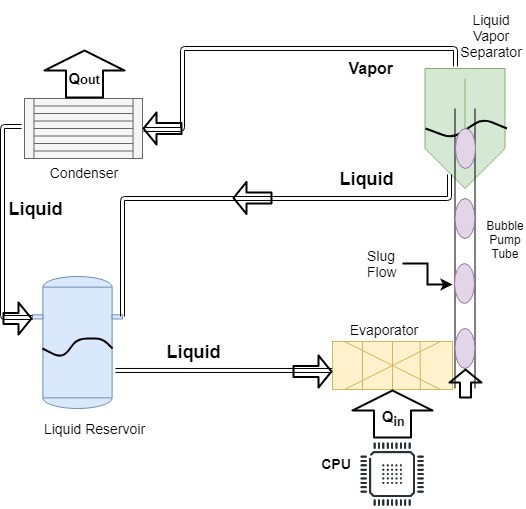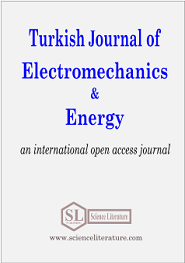
Design and performance analysis of bubble pump with water-based multi lifting tubes
Abstract
Designing any refrigeration system is critical because it should be more efficient than the previous designs. In this article, a bubble pump which is an essential equipment of an integrated cooling system, has been designed. The design conditions were assumed that a hot surface released different amounts of heat 550 W and 1500 W is to be cooled and maintain the temperature under the desirable limit. The experiments have been conducted under the atmospheric pressure used many configurations such as a different number of 8 mm diameter lifting tubes from one to four tubes and different submergence ratios 0.3, 0.4, and 0.5. The efficiency has been calculated, and at the last step, the conclusion has been extracted that the slug flow pattern could be noticed in the experiments as the desired flow type where the maximum mass flow rate is about 63 g/s at a configuration of four lifting tubes and the heat power is 1500 W. It was concluded that the performance was directly proportional to the submergence ratio and lifting tubes.
Full Text:
PDFReferences
J. Aman, P. F. Henshaw, D. S-K Ting, "Performance characterisation of a bubble pump for vapour absorption refrigeration systems," Int. Journal of Refrigeration, Vol. 85, pp. 58-69, 2018.
A. Benhmidene, B. Chaouachi, G. Silimane, M. Bourouis, “Modelling of boiling two-phase flow in the bubble pump of diffusion-absorption refrigeration cycles,” Chemical Engineering Communications, 202(1), pp. 15-24, 2015.
F. Lin, D. Liu, D. Jiang, L. Yang, & R. Zhao, “An experimental study on the performance of the guided bubble pump with multiple tubes.” Applied Thermal Engineering, Vol. 106, pp.1052-1061, 2016.
D. J. Nicklin, “The air-lift pump: Theory and optimisation.” Trans. Inst. Chem. Eng., Vol. 41, pp.29-39, 1963.
H. Yang, Y. Chen, Y. Wu, F. Yang, X. Huang, Y. Xu, W. Duan, “Thermo-fluidic characteristics and performance in a distributed heating bubble pump generator.” International Journal of Refrigeration, vol. 133. pp. 181-190, 2022.
T. Ganat, M. Hariri, “Effect of flow patterns on two-phase flow rate in vertical pipes.” Journal of Advanced Research in Fluid Mechanics and Thermal Sciences, 55(2), pp. 150-160, 2019.
A. Benhmidene, B. Chaouachi, S. Gabsi, “A review of bubble pump technologies.” J. Appl. Sci., 10(16), pp. 1806–1813, 2010.
A. Benhmidene, B. Chaouachi, S. Gabsi, M. Bourouis, “Modelling of heat flux received by a bubble pump of absorption-diffusion refrigeration cycle,” Heat Mass Trans., vo. 47, pp. 1341–1347, 2011.
A. Benhmidene, B. Chaouachi, S. Gabsi, M. Bourouis, “Effect of operating conditions on the performance of the bubble pump of absorption-diffusion refrigeration cycles,” Therm. Sci., vol. 15, pp. 793–806, 2011.
G. Montoya, D. Lucas, E. Baglietto, Y. Liao, “A review on mechanisms and models for churn-turbulent flow regime,” Chem. Eng. Sci., vol. 141, pp. 86–103, 2016.
M. Pfaff, R. Saravanan, M. P. Maiya, M. Srinivasa, “Studies on bubble pump for a water–lithium bromide vapour absorption refrigeration,” Int. J. Refrigeration, vo. 21, pp. 452–462, 1998.
S. V. Shelton, S. J. White, “Bubble pump design for single pressure absorption refrigeration cycles,” ASHRAE Trans., 108(1), pp. 867-876, 2002.
S. Walt, The design and optimisation of a bubble pump for an aqua-ammonia diffusion absorption heat pump, M.Sc. thesis, North-West University, South Africa, 2012.
E. T. White, R. H. Beardmore, “The velocity of the rise of single cylindrical air bubbles through liquids contained in vertical tubes,” Chem. Eng. Sci., vol. 17, pp. 351–361, 1962.
S. J. White, Bubble Pump Design and Performance, M.Sc. Thesis, Georgia Institute of Technology, Mechanical Engineering, Atlanta, USA. 2001.
A. Zohar, M. Jelinek, A. Levy, I. Borde, “The influence of the generator and bubble pump configuration on the performance of diffusion absorption refrigeration (DAR) system,” Int. J. Refrigeration, 31(6), pp. 962–969, 2008.
URN: https://sloi.org/urn:sl:tjoee63187
Copyright (c) 2021 Turkish Journal of Electromechanics and Energy

This work is licensed under a Creative Commons Attribution-NonCommercial 4.0 International License.

 Indexed in:
Indexed in:
















